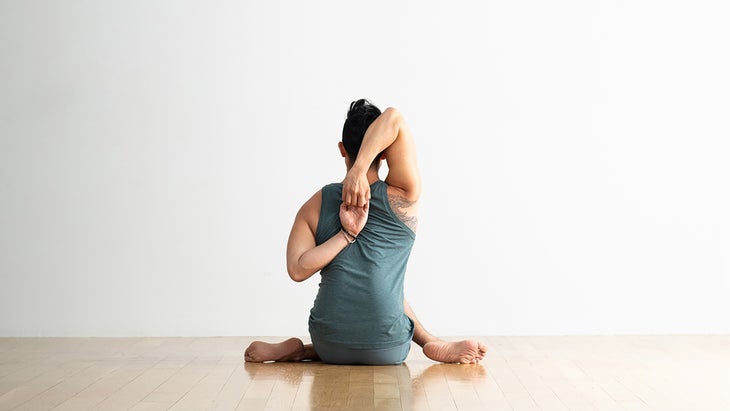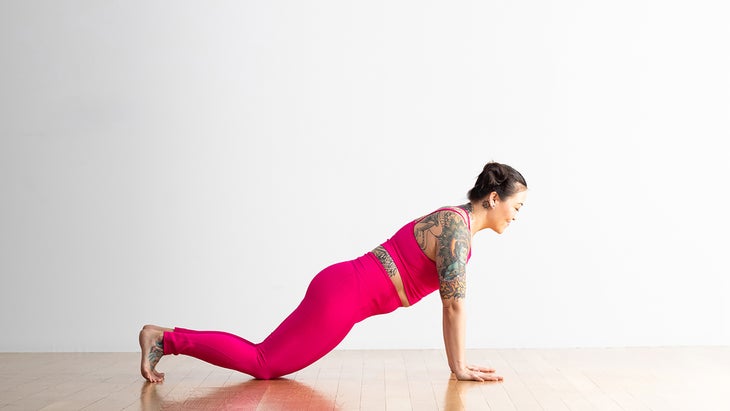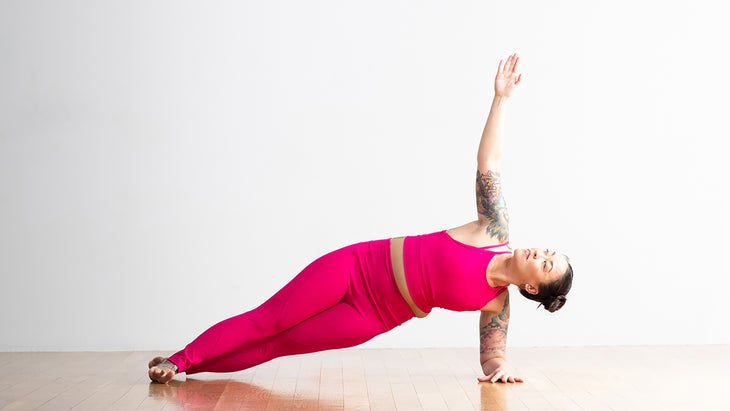New perk! Get after it with local recommendations just for you. Discover nearby events, routes out your door, and hidden gems when you sign up for the Local Running Drop.
Shoulder pain is a common complaint among triathletes, and no wonder. Your shoulders are not only put to work in the swim, but they also stabilize your body throughout your bike and run. The muscles of the rotator cuff account for a significant portion of that movement. Add to that our desk-bound lifestyle, in which our shoulders can become tight and imbalanced from hours hunched over the keyboard (“Work-From-Home Posture” is real!), and you can see how easily this area of the body can become aggravated.
Fortunately, it is possible to practice rotator cuff exercises that stretch and strengthen the muscles to relieve shoulder pain and reduce your chances of experiencing an injury. You may think going to the gym is your only option for strengthening your rotator cuff, but bolstering these muscles through yoga exercises extends their ranges of motion and prepares them for the physical demands of your training, your workday, or any other pursuits.
RELATED: Ask a Trainer: What is Swimmer’s Shoulder?
What is the rotator cuff?

The rotator cuff is a group of four muscles that stabilizes the upper arm bone in the shoulder socket and allows the shoulder to rotate. The rotator cuff muscles include:
- Supraspinatus: helps you lift your arm
- Infraspinatus: externally rotates your arm
- Teres minor: stabilizes the glenohumeral joint
- Subscapularis: internally rotates your arm
Abrupt movements, especially ones that require lots of force when pressing or pulling, can increase the challenges that these tissues face. The tendons can become irritated from repetitive motion, especially when there is weakness in the muscles that stabilize the shoulder blades and anchor the rotator cuffs.
Where do you feel rotator cuff pain?
Because there are four muscles and their tendons, a wide range of symptoms can fall under the rotator cuff. Generally, pain is felt over the top of the shoulder, but it can extend to almost anywhere around the shoulder joint itself, including the shoulder blade or the armpit.
Tearing your rotator cuff is commonly associated with baseball players because of the forceful motion of throwing a pitch, but rotator cuff injury is also common in yoga practitioners, rock climbers, swimmers, golfers, and tennis players due to the demands placed on the shoulder joint.
3 yoga-based exercises to stretch and strengthen the rotator cuff
By practicing rotator cuff exercises that bolster and the muscles around the shoulder joint and restore your range of motion, you can create a stronger, more supportive structure as you move, which can decrease your chance of experiencing a rotator cuff tear or facilitate your recovery from injury.

Gomukhasana (Cow Face Pose), variation
How it supports the rotator cuff: This pose stretches the entire rotator cuff with a combination of internal and external rotation of the arms, improving range of motion. If your shoulders are tight, you can do this pose in a warm shower or hold onto a strap or towel if you can’t reach your hands.
How to practice: From a seated or standing position, reach your left arm straight out to the left, parallel to the floor. Rotate your left arm inward; the thumb will turn first toward the floor, then point toward the wall behind you, with the palm facing the ceiling. This movement will roll your left shoulder slightly up and forward, and will round your upper back. With a full exhalation, sweep the left arm behind your torso and tuck the forearm in the hollow of your lower back, parallel to your waist, with the left elbow against the left side of your torso. Roll the shoulder back and down; then work the forearm up your back until it feels parallel to your spine. The back of your hand will be between your shoulder blades.
Inhale and stretch your right arm straight forward, parallel to the floor. Turn the palm up, inhale, and stretch your arm straight up toward the ceiling, palm turned back. Bend your elbow and reach down for the left hand. If you can, clasp your hands. If you can’t reach, start over with a towel or strap in your overhead hand. Hold for 30 seconds, then repeat on the other side.

Plank Pose, variation
How it strengthens the rotator cuff: This motion is reminiscent of a scapular push-up. Plank Pose strengthens the muscles around the shoulder blade (the levator scapulae, rhomboids, and serratus anterior) which provides a strong foundation that braces the rotator cuff.
How to practice: Come into Tabletop. As you exhale, without bending your elbows, lower your rib cage toward the floor and draw your shoulder blades toward each other. As you inhale, push the floor away, pull your rib cage away from the floor, and, without rounding the spine, spread your shoulder blades apart. You can keep your knees on the floor or come into Plank Pose and try the same movement there. Visualize your shoulder blades gliding toward and away from each other around your rib cage. Repeat 10 times, rest for a few breaths, and repeat. As your muscles grow stronger, work your way up to 15 or 20 repetitions.

Vasisthasana (Side Plank Pose), variation
How it strengthens the rotator cuff: Side Plank makes the muscles of the rotator cuff work as an integrated unit to keep your lowered arm and torso stable while they exert force.
How to practice: Come onto your forearms with your elbows under your shoulders and your feet together. Roll onto the edge of your left foot and place your right foot down in front of it for stability. Turn your left forearm in 45 to 90 degrees. Hug your left arm bone into the shoulder socket and press the base of your left index finger into the floor. Lift and lengthen the sides of the rib cage and extend your right arm up. Hold for 30 to 60 seconds; then repeat this variation of Side Plank on the other side.
RELATED: Ask A Trainer: Why Do My Neck and Shoulders Hurt After Riding?